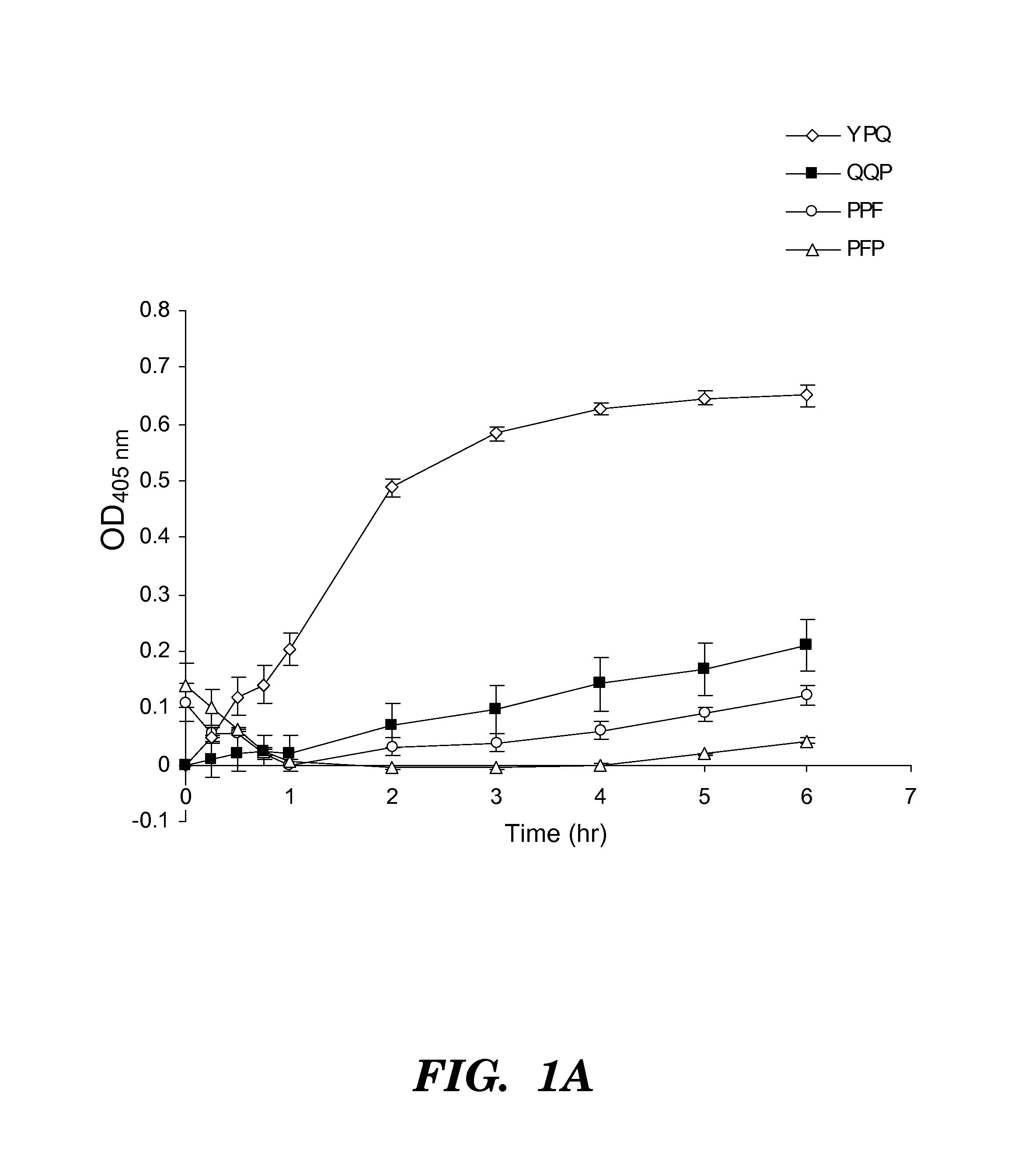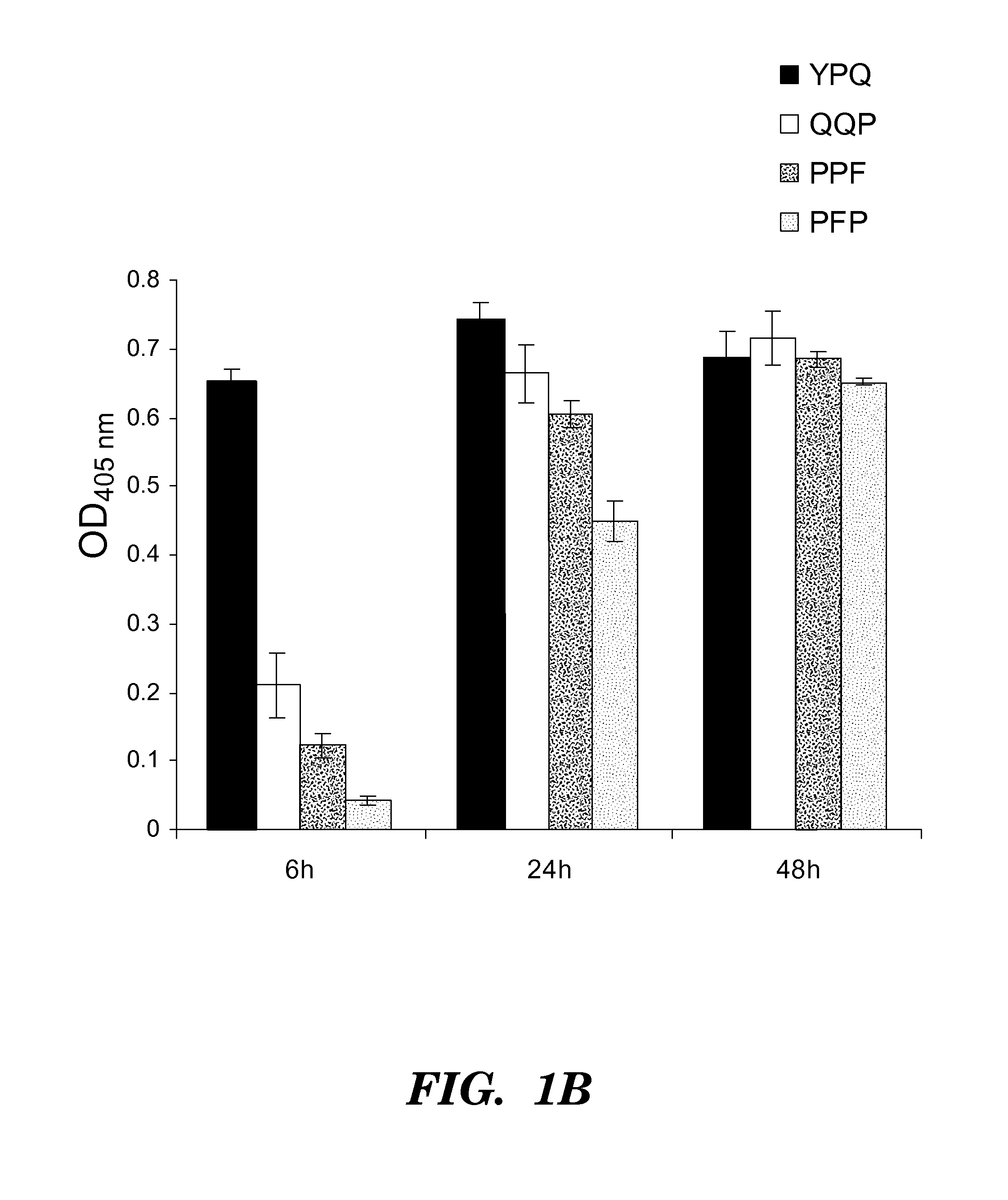Rothia species gluten-degrading enzymes and uses thereof
a technology of gluten-degrading enzymes and rothia species, which is applied in the field of gluten-degrading enzymes and/or the treatment of celiac disease, can solve the problems of erroneous diagnosis of eczema, eliciting an immune response, and variety of generalized gastro-intestinal disease symptoms, so as to reduce the severity of symptoms, improve the clinical symptoms of subjects, and slow or reverse the progression or anticipated progression.
- Summary
- Abstract
- Description
- Claims
- Application Information
AI Technical Summary
Benefits of technology
Problems solved by technology
Method used
Image
Examples
example 1
Exemplary Materials and Methods
Dental Plaque and Whole Saliva Collection
[0269]Protocols for the collection of human dental plaque and whole saliva (WS) were approved by the Institutional Review Board at Boston University. Plaque was obtained from a healthy subject 48 h after cessation of oral hygiene. The sample was collected from interproximal spaces using a sterile dental scaler and suspended in saliva ion buffer containing 50 mM KCl, 1.5 mM potassium phosphate, 1 mM CaCl2 and 0.1 mM MgCl2, pH 7.0 14 . The plaque material was dispersed by pipetting and vortexing and the density of the resulting suspension was determined spectrophotometrically at 620 nm. Stimulated WS (5 ml) was collected from eight healthy subjects between 10.00 and 11.00 a.m. at least 1 hour after the last meal. Whole saliva flow was stimulated by mastication using 1 g of paraffin wax (Parafilm, American National Can™, Chicago, Ill.). All samples were kept on ice.
Enzyme Activity Analysis
[0270]Four synthetic analo...
example 2
Structural Similarities between Gliadins and Basic PRPs
[0280]The recent discovery of an oral glutamine endoprotease cleaving basic PRPs prompted the inventors to study their capability to cleave immunogenic epitopes of gliadins which drive intestinal inflammation in celiac disease. When the primary amino acid sequences of gliadins and basic PRPs were compared, both protein families were found to share structural features. First, both gliadins and basic PRPs are very similar in size, averaging 307 and 357 amino acids (including signal peptides), respectively. Second, in gliadins as well as basic PRPs the amino acids glutamine (Q) and proline (P) combined make up about 50% of the total amino acid composition (Table 1). A noticeable difference though is that the relative proportions of glutamine and prolines in gliadins and basic PRPs is reversed (Table 1). Third, the XPQ sequence, prevalent in basic PRPs is also frequently occurring in gliadins. An example of a comparison between the ...
example 3
Protease Identification in Rothia mucilaginosa ATCC 25296
Diethylaminoethyl Cellulose (DEAE) Ion-Exchange Chromatography
[0292]A DEAE column was prepared in house by using DEAE Sepharose Fast Flow resin, a weak anion exchange resin (GE Healthcare, Bjorkgatan, Sweden). The column the size was 2.6 cm×82.5 cm containing a volume of 438 ml. The chromatographic separation of proteins was achieved using the FPLC system AKTApurifier (GE Healthcare, Bjorkgatan, Sweden) at a flow rate of 1 ml / min with buffer A composed of 50 mM Tris-HCl, pH 8.0 and buffer B composed of 50 mM Tris-HCl, 1 M NaCl, pH8.0. The gradient applied was 0% buffer B over 657 min; 0-35%, 1533 min; 35-100%, 44 min; and 100%, 219 min. Fractions of 10 ml were collected. Enzyme activities in fractions of interest were assessed by adding Z-YPQ-pNA to a final concentration of 150 μM and following substrate hydrolysis spectrophotometrically at 405 nm (See FIG. 11). The peaks containing proteins with enzymatic activities were sub...
PUM
| Property | Measurement | Unit |
|---|---|---|
| isoelectric point | aaaaa | aaaaa |
| pH | aaaaa | aaaaa |
| molecular weight | aaaaa | aaaaa |
Abstract
Description
Claims
Application Information
 Login to View More
Login to View More - R&D
- Intellectual Property
- Life Sciences
- Materials
- Tech Scout
- Unparalleled Data Quality
- Higher Quality Content
- 60% Fewer Hallucinations
Browse by: Latest US Patents, China's latest patents, Technical Efficacy Thesaurus, Application Domain, Technology Topic, Popular Technical Reports.
© 2025 PatSnap. All rights reserved.Legal|Privacy policy|Modern Slavery Act Transparency Statement|Sitemap|About US| Contact US: help@patsnap.com



